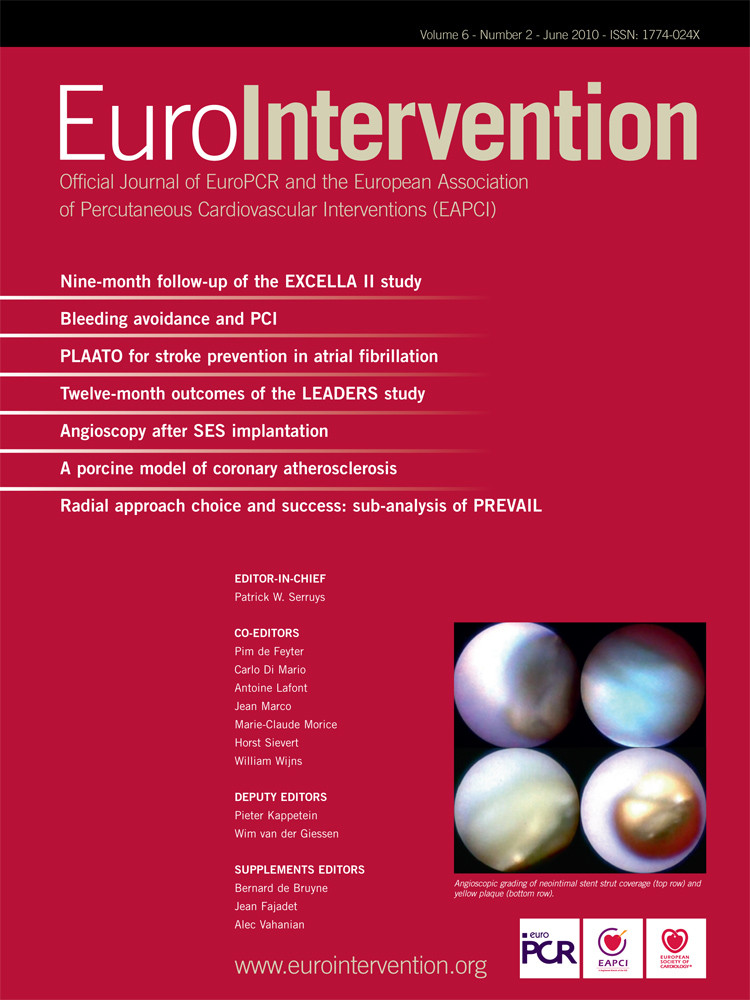There is mounting evidence that the use of the radial access, without compromising procedural success, reduces bleeding complications compared to the femoral. Despite the proven efficacy, safety and benefits, the rate of penetration of radial access worldwide is still low – around 10% with a wide variation in adoption from over 50% in France, 40% in Japan to as little as 1% in the US (around 5% according to most recent data). The benefits that are inherent to the radial approach occur when radial approach is used in >70% of patients. Like any new technique, the radial approach has an inherent learning curve which may be shortened by a properly implemented radial programme and optimal access technique1.
In the current issue of this journal there are three articles on the radial approach which are focused on: predictors of choice and success; the effect of different heparin regimens on patency; and new puncture techniques.
In a subanalysis of the previously published PREVAIL study, Pristipino et al have tried to identify the predictors of the choice and success rates of radial artery catheterisation (RAC) in contemporary real world cardiology practice2. To date, this is the first study that has sought to identify these factors formally in a large cohort of unselected patients undergoing RAC by operators with different levels of expertise and across centres with varying volumes of activity. The first original finding is that in 90% of cases the choice of first arterial access site was determined by operator preference, while clinical or technical factors affected the choice in only a small minority. Patients undergoing RAC at hospitals with high overall procedural volumes exhibited a similar rate of RAC failure as those undergoing the procedure at low volume hospitals. However, assessing RAC volumes alone, patients undergoing the procedure at high volume hospitals experienced a statistically lower rate of RAC failure than their low-volume hospital counterparts. The failure rate for first radial access decreased almost tenfold, from 33% to 3.8%, when operators with <25% of their case load performed by RAC were compared against those with >85% of their personal case load performed by RAC. Currently, radial access failure rate for high-volume operators performing over 90% of procedures radially is less than 1%3. The authors conclude that a routine RAC is superior to a selective strategy in terms of feasibility and success rate. For the first time, the study provides evidence that, contrary to general belief, the routine use of RAC in all-comers is feasible, safe and more successful than its selective use.
In the second article, Ludvwig et al describe a new approach for RA puncture that represents a combination of the two most frequently techniques used nowadays, namely the bare needle technique and the venous cannula puncture technique4. The choice between the two cited techniques is mainly operator dependent, and none of the two has emerged as clearly better than the other5. The modified radial puncture technique combines the advantages of the bare needle and venous cannula techniques. The proposed approach is achieved in two steps: First, the radial puncture is accomplished with a bare needle without local anaesthesia, and according to the authors, patient discomfort is minimal and radial spasm virtually eliminated. In the second step, the combination of the retrieved needle introduced into a venous cannula is inserted over the introducer wire into the artery. The described modification of mainstream techniques does not make easier or shorter the access to the radial artery and it may be even slightly more time-consuming. The main advantage, however, is not an easier puncture, but the ability to perform angiography and locally apply drugs, if needed, before a sheath is introduced.
In the third article, the elegantly designed study by Schiano et al focuses – for the first time – on the potential influence of different heparin regimens on radial artery occlusion and bleeding complications during elective transradial coronary angiography6. Radial artery occlusion occurs in around 5% of patients and is as a rule is asymptomatic, but may limit repeat radial access or use of the radial artery for bypass graft or haemodialysis. Administration of 5000 IU of heparin upon sheath insertion is the current practice in most radial cathlabs. As has been recently demonstrated, applying patent haemostasis under guided compression has been shown to decrease the rate of RA occlusion at 30 days by 75%7.
The purpose of the study was to determine whether the use of a weight-adjusted dose of heparin would impact radial occlusion and bleeding rates. It included 162 patients, 79 randomised to group A (standard 5000UI dose of unfractionated heparin) and 83 to group B (weight-adjusted UFH – 50UI/kg), without, however, exceeding the maximum dose of 5000UI. Haemostasis was ensured by means of a TR Band® radial artery compression system, avoiding excessive compression which was gradually deflated as per protocol. Radial artery patency, the primary endpoint, was evaluated with Doppler before discharge from the hospital. Weight-adjusted heparin dose led to lower ACT level and decrease in radial compression time without increasing radial artery occlusion rates. No radial occlusion was noted in both groups. Local haematoma was less frequent in the 50 IU/kg group, but the difference was not statistically significant. The authors concluded that the use of weight-adjusted heparin during radial diagnostic coronary angiography is safe and efficient, without any increased risk of radial occlusion and that its impact on bleeding complication needs further evaluation in larger series.

